 |
Applied Microscopy. The Microscopy of Vinyl Recordings. Surface Contamination, Old Styli. |
Page 3 of 4 |
 |
Applied Microscopy. The Microscopy of Vinyl Recordings. Surface Contamination, Old Styli. |
Page 3 of 4 |
The particles which obstruct the grooves of, and detract from the listening experience provided by, vinyl records can be, as you would expect, of animal, vegetable or mineral origin. The two pictures below show one animal and one vegetable agent -- the latter following close upon the heels of the former for reasons which will become apparent. The animal (below) is a young silverfish with its extended cercae overlapping the closing bars of the final movement of Bruckner's third symphony. I mention this as it is not possible to tell from the photograph. There are few places in a Bruckner symphony where the sound of a diamond stylus colliding with a dead silverfish would be less welcome. The cadaver was removed by brushing with a carbon fibre brush. 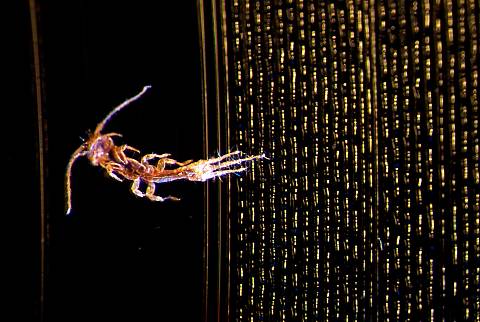
Dead silverfish on a vinyl record surface. x35. The vegetable agent in the picture below is an anonymous fungus. The mycelial threads are seen radiating from small lumps stuck on the record surface which are dried silverfish droppings. Four as yet fungally unexploited items of the same kind are seen in the right-hand portion of the picture. It has been estimated that one silverfish turd would keep the average fungus happily fed for God knows how long -- depending on the temperature and humidity conditions in the location of your record collection. Fortunately, all of this softens easily when water is applied, so unless the fungus is one of those that manages to etch itself into the vinyl, a careful wash or a local scrub with a wet cotton bud will remove it. If you do this, it is essential that any water applied be removed immediately with absorbent tissue. Any residues allowed to dry out on the record surface, including minerals in apparently clean tap water, can be very difficult to remove later. 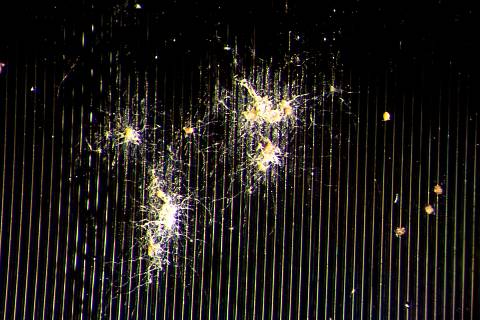
Fungus growing on a vinyl record surface. x35. Organic contamination of record surfaces includes things like impressed dandruff flakes, dried specks of saliva resulting from conversations conducted during the record changing process, crumbs from the last cheese sandwich you made, etc. Any of these specks will provide ample nourishment for any fungal spore fortunate enough to be contained in it or land on it. Storage of records in a warm, damp place (or even a cold, damp place) will then guarantee fungal longevity and record unplayability. This picture shows a cheap diamond stylus with a spherical tip. The diamond is the dark portion at the top of the conical structure. It is fused to a metal mount which is glued into a hole in a hollow aluminium(?) arm called the cantilever. 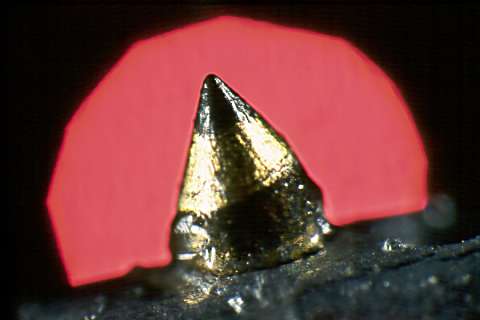
A spherical diamond stylus from a cheap cartridge. The picture below is of a replacement stylus assembly of which the top picture is a part. The cantilever is fitted with two styli having a 180 degree rotation lever which brings one stylus or the other into the playing position. The lower stylus is a coarse spherical (probably sapphire) tip for playing 78 rpm records. 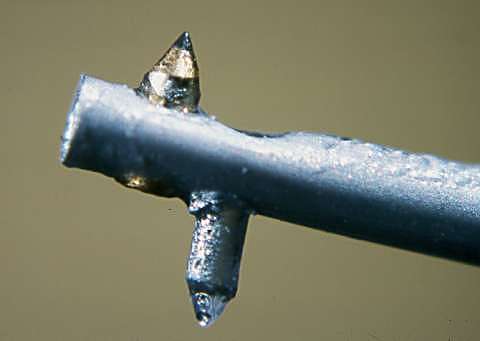
A turnover stylus assembly for a dual LP/78 rpm player. The next picture shows one of many disasters which can befall a stylus -- or more specifically, its cantilever. 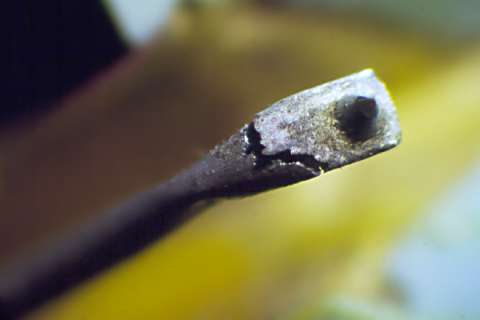
Fractured stylus cantilever from a consumer-level record deck. The picture below shows wear in the loud passages of a fifties vinyl record (the final moments of Grieg's piano concerto played by Moura Lympany and the Philharmonia under Herbert Menges). This record has probably been played with the kinds of stylus shown above, at the often brutal tracking forces which were common in this period of transition between 78s and vinyl. 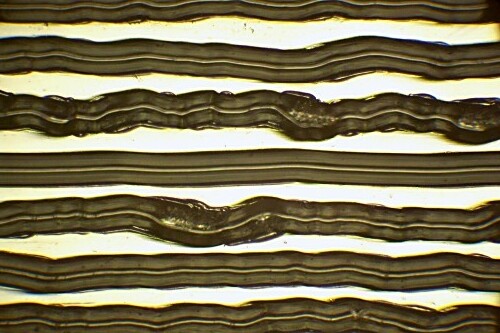
Wear in the loud passages of a mono vinyl record. Brightfield Vertical Illumination. x200. The picture can be interpreted if the viewer imagines a stationary stylus, with the record grooves moving from right to left beneath it -- as in a normal turntable/arm setup. The bright line in the centre of the groove is the (almost) V-shaped bottom produced by the cutting head, and preserves the shape of the groove modulation most clearly, given that the upper wall is so severely damaged. The places where the stylus impacts the heavier modulations are marked by obvious damage to the groove wall, and a raised lip of vinyl above the record surface. Stylus rebound then causes similar damage to the opposite wall. The appearance of these injuries suggests the generation of sufficient heat to cause instantaneous melting, or at least softening, of the vinyl. Another revealing feature of this picture is the lighter-shaded band seen most clearly on the walls of the less modulated (straighter) grooves. This marks the area of moving contact between the stylus and the groove wall, and a close examination of the varying width of this contact band gives an insight into the forces exerted on each wall of the groove during playback. It can also be seen that in the loud passages where severe mistracking occurs, sections of the groove wall are not contacted at all. The next page deals in detail with the elliptical diamond stylus and the level of wear which leads to mistracking of the record. Updated 8th. August, 2005. |